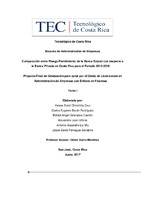Mostrar el registro sencillo del ítem
Comparación entre riesgo/rendimiento de la banca estatal con respecto a la banca privada en Costa Rica para el periodo 2012-2016
| dc.contributor.advisor | Victor Garro Martínez | es |
| dc.contributor.author | Chinchilla-Cruz, Yeison Estid | |
| dc.contributor.author | Durán-Rodríguez, Carlos Eugenio | |
| dc.contributor.author | Granados-Castillo, Rafael Angel | |
| dc.contributor.author | León-Urbina, Alexandro | |
| dc.contributor.author | Liu-Wu, Antonio Alejandro | |
| dc.contributor.author | Paniagua-Sanabria, Josué David | |
| dc.date.accessioned | 2018-11-12T18:55:14Z | |
| dc.date.available | 2018-11-12T18:55:14Z | |
| dc.date.issued | 2017 | |
| dc.identifier.uri | https://hdl.handle.net/2238/10055 | |
| dc.description | Proyecto de graduación (Licenciatura en Administración de Empresas. Enfasis en Finanzas) Instituto Tecnológico de Costa Rica, Escuela de Administración de Empresas, 2017. | es |
| dc.description.abstract | This work, raise the hypothesis which is to prove if the Ratio between Risk and Return is the same comparing publicly own banks and privately own banks. We wonder how there is a general assumption that Public companies cannot or will not be as profitable as Private companies? Understanding that public and private banks operate under mostly the same market, under the same supervision and general rules for quite a few decades now. Then, why do we keep assuming there has to be a difference between the relationships Risk/Returns? Now, how do we plan to compare these entities, evaluate their weight into the results and also with interviews to experts in the area get there evaluation inputs? Evaluate the Return over Assets (ROA) as well as the Return over Equity (ROE) We started the approach by selecting the Risk and Return formulas which we are to use to compare yearly results. Based on the formulas, we establish that we have to gather information on Total Assets, Owners equity and also we use the annual Revenue generated before any taxes or legal transfers. Once we had the information from 2011 to 2016, we calculated the ratios, and with those ratios, we had the yearly results on each one of the banks in the banking sector. Once we have the yearly results on every institution, we calculated a weighted average for the 5 year period of analysis, and based on these results we calculated the Ratio between Risk/Return. In order to be consistent with the analysis, we calculated the weighted average as well on the Revenue Generated by each institution, and those results also provided an estimate which we use to evaluate the deviation from the average. Having all these information we were able to validate our hypothesis, and establish that there are parameters which will make the ratio Risk/Return to be equal among Public and Private Banks at the Costa Rican market. As part of our conclusions, we were able to establish that there are relevant and proper supervision from the CONASIFF and the SUGEF which is the entity that overlooks banking performance. The results we gather out of the Public Banks, shows the benefits of handling some institutional deposits, which they will recognized very low return. As for the Private banking, we found their risk to be more related to the Exchange Market, focus their returns in short to medium term projects, revenue generating markets, like commercial banking, credit cards and related services. Also, we cannot go by without mentioning the way Banks and Corporate boards are established. Each one of the experts concurs than Private boards have been growing with more knowledgeable people in the market. Although there are several people on the Public sector which have grown and are part of the analysis, most of the board decision makers at the Public banks are there mostly due to political links, rather than their expertise in the area. | es |
| dc.description.sponsorship | Instituto Tecnológico de Costa Rica. Escuela de Administración de Empresas | es |
| dc.language.iso | spa | es |
| dc.publisher | Instituto Tecnológico de Costa Rica. | es |
| dc.rights | acceso abierto | es |
| dc.subject | Finanzas | es |
| dc.subject | Banca -- Costa Rica | es |
| dc.subject | Economía | es |
| dc.title | Comparación entre riesgo/rendimiento de la banca estatal con respecto a la banca privada en Costa Rica para el periodo 2012-2016 | es |
| dc.type | proyecto fin de carrera | es |


